
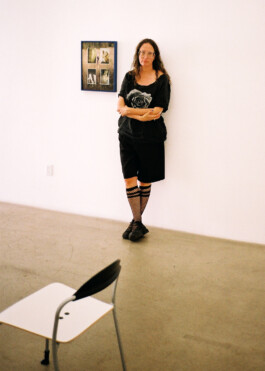
Blurred Edges
Dreams don’t always happen elsewhere. In this conversation, Hertta Kiiski invites us into a world where reality and reverie run side by side, where tenderness meets unease, and family, animals, and objects share the stage – each carrying its own quiet story, shaping a practice as intimate as it is expansive.


Was there a moment when you first realised the everyday could be transformed into something dreamlike?
I don’t think it was a moment – more like something I’d been standing in my whole life without naming it. I’ve always had strong dreams, but they never felt… elsewhere. The imagination isn’t a place you visit; it’s right here, running alongside reality like two kids on parallel sidewalks. Sometimes they hold hands, sometimes they just glance at each other. The everyday and the dream are the same breath, moving in and out in slow motion.
“The imagination isn’t a place you visit; it’s right here, running alongside reality like two kids on parallel sidewalks.”


Your work spans photography, sculpture, textiles, and film – how do you decide which medium a story wants to live in?
I don’t so much choose a medium as listen. Some ideas arrive as a single, stubborn image that refuses to move. Others feel restless, like they need to breathe or be touched. Sometimes a story is so quiet it can only be sewn into fabric. Other times it needs the flicker of a screen, as if motion is the only thing keeping it from disappearing.
Each feeling, each story, has its own texture, weight, and rhythm. Sometimes an image alone is enough; sometimes it wants presence and volume, to take up space like a sculpture. Textiles bring softness and tactility; film brings time and sound. I try to hear what the work itself wants – how it wants to speak. The medium becomes a collaborator. And I’m always thinking about context – the space where it will live matters as much as the work itself.


Many of your works merge human, animal, and object – what draws you to these hybrid forms?
It just feels truer this way. We’re already hybrids – bacteria living inside us like quiet roommates, microplastics in placentas like confetti we never meant to throw, fungi in the soil feeding the plants that feed us. Everything is already entangled.
I’m drawn to that blurred edge where one thing becomes another – where a shadow could be a person, skin could be bark, a heartbeat could belong to someone else. It’s also about giving space and dignity to the more-than-human world, letting animals, plants, and other beings stand beside us, not as symbols but as themselves. Even objects have quiet souls, carrying the weight of all the hands, rooms, and lives they’ve passed through.
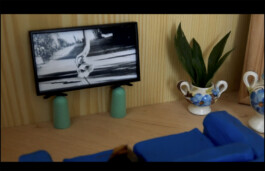
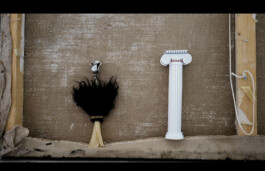
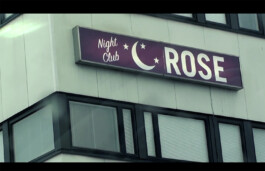
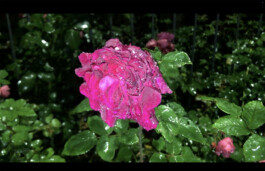
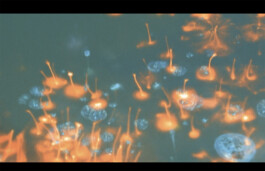
Nox Rosae video by Hertta Kiiski & Janne Punkari
Nox Rosae video by Hertta Kiiski & Janne Punkari
Nox Rosae video by Hertta Kiiski & Janne Punkari
Nox Rosae video by Hertta Kiiski & Janne Punkari
Nox Rosae video by Hertta Kiiski & Janne Punkari
“Tenderness and unsettlement are like twins holding hands; if you separate them, they lose their shape.”
Your work feels both tender and unsettling – how conscious are you of balancing those moods?
That tension is always present in my mind. I don’t try to balance them – tenderness and unsettlement are like twins holding hands; if you separate them, they lose their shape. A soft, even cute thing can be frightening, and something frightening can be soft and cute.
They’re often two sides of the same experience – intimacy can be fragile, even threatening. I want the work to hold that complexity, to invite viewers into a space where beauty, unease, and the quiet presence of other beings coexist, opening the door to deeper emotional resonance.

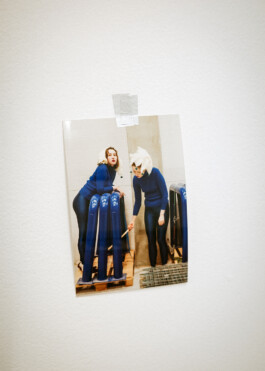
Your daughters, niece, and dogs often appear in your work – what’s it like to collaborate so closely with family?
It’s like living inside a tiny, loving circus. We’ve been making art together for almost fifteen years, so the rhythm of creating and living is braided into one. Everyone is around all the time, which makes it practical in the best way.
There’s a trust and intimacy you can’t fake – a knowing of silences as well as voices. Over the years, collaborating with them has taught me patience, attention, and how small gestures make life, and art, feel alive. The line between the two blurs, and with it comes the care of holding these relationships gently, like they’re still warm from someone’s hands. Even the presence of our dogs or a familiar object feels like part of the choreography; everyone in the space matters, not just the humans.


Your current show at Noon Gallery, Fever Dream, brings together sculpture, photographic assemblage, and film – what was the starting point for this body of work, and how did its theme take shape?
It began in that narrow space between collapse and care – where things fall apart and something unexpectedly warm appears at the edges. Moments when reality seems to dissolve or shimmer differently, like a fever dream, became my compass.
I gathered fragments, images, and objects that carried this liminal charge, letting them accumulate until they felt like a family of strange cousins: some still, some moving, together forming a small ecosystem of their own.
The show is less a story than a space – a lucid, looping dream where boundaries blur between species, objects, the natural, and the made. It moves like REM sleep, inviting drift instead of direction. At its center, the video works hold the tension most fully, while sculptures and photographic assemblages orbit them, heavy with personal histories, cultural debris, and ecological unease – yet balanced, just enough to keep breathing.
“Sometimes I feel like the studio is less mine and more a neighborhood of objects that have chosen to live here.”


You also teach – how do you balance the solitude of your own studio work with the energy and responsibility of mentoring students? Do those worlds feed into each other?
Teaching pulls me out of my own head and into a room alive with unfinished sentences and impossible questions. I love that – my work feels like that too, full of open doors.
But I also need long stretches of solitude, where ideas can grow unruly and find their own shape. That quiet is what keeps both the studio and the classroom alive – like tuning a radio in the dark and catching an unexpected station.


What’s the strangest object in your studio right now?
My studio is full of strange things – it’s hard to pick just one. I collect anything that speaks to me, because you never know when it might be needed. I even bring home trash from the streets of LA.
Right now, I’m carrying a pair of beautiful, empty toilet paper rolls, haha. And there’s a beige, adult-size bathtub just sitting there, waiting for its moment in the next exhibition. Flea markets are my meditation – I love going through them, imagining the lives objects have lived, the stories they might carry next. Sometimes I feel like the studio is less mine and more a neighborhood of objects that have chosen to live here.


“It’s like living inside a tiny, loving circus.”


How do you imagine your art evolving in the next decade?
I hope to keep wandering around the edges where image, object, and story meet – letting them spill into shapes and collaborations I can’t yet predict. I want to keep returning to the things I feel compelled to talk about, the little obsessions that stick with me.
Above all, I want the work to keep surprising me, to catch me off guard. And I hope to keep collaborating more and more – following the ways other people, voices, and even materials can pull the work into places I never knew existed.


Blurred Edges

Dreams don’t always happen elsewhere. In this conversation, Hertta Kiiski invites us into a world where reality and reverie run side by side, where tenderness meets unease, and family, animals, and objects share the stage – each carrying its own quiet story, shaping a practice as intimate as it is expansive.


Was there a moment when you first realised the everyday could be transformed into something dreamlike?
I don’t think it was a moment – more like something I’d been standing in my whole life without naming it. I’ve always had strong dreams, but they never felt… elsewhere. The imagination isn’t a place you visit; it’s right here, running alongside reality like two kids on parallel sidewalks. Sometimes they hold hands, sometimes they just glance at each other. The everyday and the dream are the same breath, moving in and out in slow motion.
“The imagination isn’t a place you visit; it’s right here, running alongside reality like two kids on parallel sidewalks.”


Your work spans photography, sculpture, textiles, and film – how do you decide which medium a story wants to live in?
I don’t so much choose a medium as listen. Some ideas arrive as a single, stubborn image that refuses to move. Others feel restless, like they need to breathe or be touched. Sometimes a story is so quiet it can only be sewn into fabric. Other times it needs the flicker of a screen, as if motion is the only thing keeping it from disappearing.
Each feeling, each story, has its own texture, weight, and rhythm. Sometimes an image alone is enough; sometimes it wants presence and volume, to take up space like a sculpture. Textiles bring softness and tactility; film brings time and sound. I try to hear what the work itself wants – how it wants to speak. The medium becomes a collaborator. And I’m always thinking about context – the space where it will live matters as much as the work itself.


Many of your works merge human, animal, and object – what draws you to these hybrid forms?
It just feels truer this way. We’re already hybrids – bacteria living inside us like quiet roommates, microplastics in placentas like confetti we never meant to throw, fungi in the soil feeding the plants that feed us. Everything is already entangled.
I’m drawn to that blurred edge where one thing becomes another – where a shadow could be a person, skin could be bark, a heartbeat could belong to someone else. It’s also about giving space and dignity to the more-than-human world, letting animals, plants, and other beings stand beside us, not as symbols but as themselves. Even objects have quiet souls, carrying the weight of all the hands, rooms, and lives they’ve passed through.





Nox Rosae video by Hertta Kiiski & Janne Punkari
Nox Rosae video by Hertta Kiiski & Janne Punkari
Nox Rosae video by Hertta Kiiski & Janne Punkari
Nox Rosae video by Hertta Kiiski & Janne Punkari
Nox Rosae video by Hertta Kiiski & Janne Punkari
“Tenderness and unsettlement are like twins holding hands; if you separate them, they lose their shape.”
Your work feels both tender and unsettling – how conscious are you of balancing those moods?
That tension is always present in my mind. I don’t try to balance them – tenderness and unsettlement are like twins holding hands; if you separate them, they lose their shape. A soft, even cute thing can be frightening, and something frightening can be soft and cute.
They’re often two sides of the same experience – intimacy can be fragile, even threatening. I want the work to hold that complexity, to invite viewers into a space where beauty, unease, and the quiet presence of other beings coexist, opening the door to deeper emotional resonance.


Your daughters, niece, and dogs often appear in your work – what’s it like to collaborate so closely with family?
It’s like living inside a tiny, loving circus. We’ve been making art together for almost fifteen years, so the rhythm of creating and living is braided into one. Everyone is around all the time, which makes it practical in the best way.
There’s a trust and intimacy you can’t fake – a knowing of silences as well as voices. Over the years, collaborating with them has taught me patience, attention, and how small gestures make life, and art, feel alive. The line between the two blurs, and with it comes the care of holding these relationships gently, like they’re still warm from someone’s hands. Even the presence of our dogs or a familiar object feels like part of the choreography; everyone in the space matters, not just the humans.


Your current show at Noon Gallery, Fever Dream, brings together sculpture, photographic assemblage, and film – what was the starting point for this body of work, and how did its theme take shape?
It began in that narrow space between collapse and care – where things fall apart and something unexpectedly warm appears at the edges. Moments when reality seems to dissolve or shimmer differently, like a fever dream, became my compass.
I gathered fragments, images, and objects that carried this liminal charge, letting them accumulate until they felt like a family of strange cousins: some still, some moving, together forming a small ecosystem of their own.
The show is less a story than a space – a lucid, looping dream where boundaries blur between species, objects, the natural, and the made. It moves like REM sleep, inviting drift instead of direction. At its center, the video works hold the tension most fully, while sculptures and photographic assemblages orbit them, heavy with personal histories, cultural debris, and ecological unease – yet balanced, just enough to keep breathing.
“Sometimes I feel like the studio is less mine and more a neighborhood of objects that have chosen to live here.”


You also teach – how do you balance the solitude of your own studio work with the energy and responsibility of mentoring students? Do those worlds feed into each other?
Teaching pulls me out of my own head and into a room alive with unfinished sentences and impossible questions. I love that – my work feels like that too, full of open doors.
But I also need long stretches of solitude, where ideas can grow unruly and find their own shape. That quiet is what keeps both the studio and the classroom alive – like tuning a radio in the dark and catching an unexpected station.


What’s the strangest object in your studio right now?
My studio is full of strange things – it’s hard to pick just one. I collect anything that speaks to me, because you never know when it might be needed. I even bring home trash from the streets of LA.
Right now, I’m carrying a pair of beautiful, empty toilet paper rolls, haha. And there’s a beige, adult-size bathtub just sitting there, waiting for its moment in the next exhibition. Flea markets are my meditation – I love going through them, imagining the lives objects have lived, the stories they might carry next. Sometimes I feel like the studio is less mine and more a neighborhood of objects that have chosen to live here.


“It’s like living inside a tiny, loving circus.”


How do you imagine your art evolving in the next decade?
I hope to keep wandering around the edges where image, object, and story meet – letting them spill into shapes and collaborations I can’t yet predict. I want to keep returning to the things I feel compelled to talk about, the little obsessions that stick with me.
Above all, I want the work to keep surprising me, to catch me off guard. And I hope to keep collaborating more and more – following the ways other people, voices, and even materials can pull the work into places I never knew existed.
